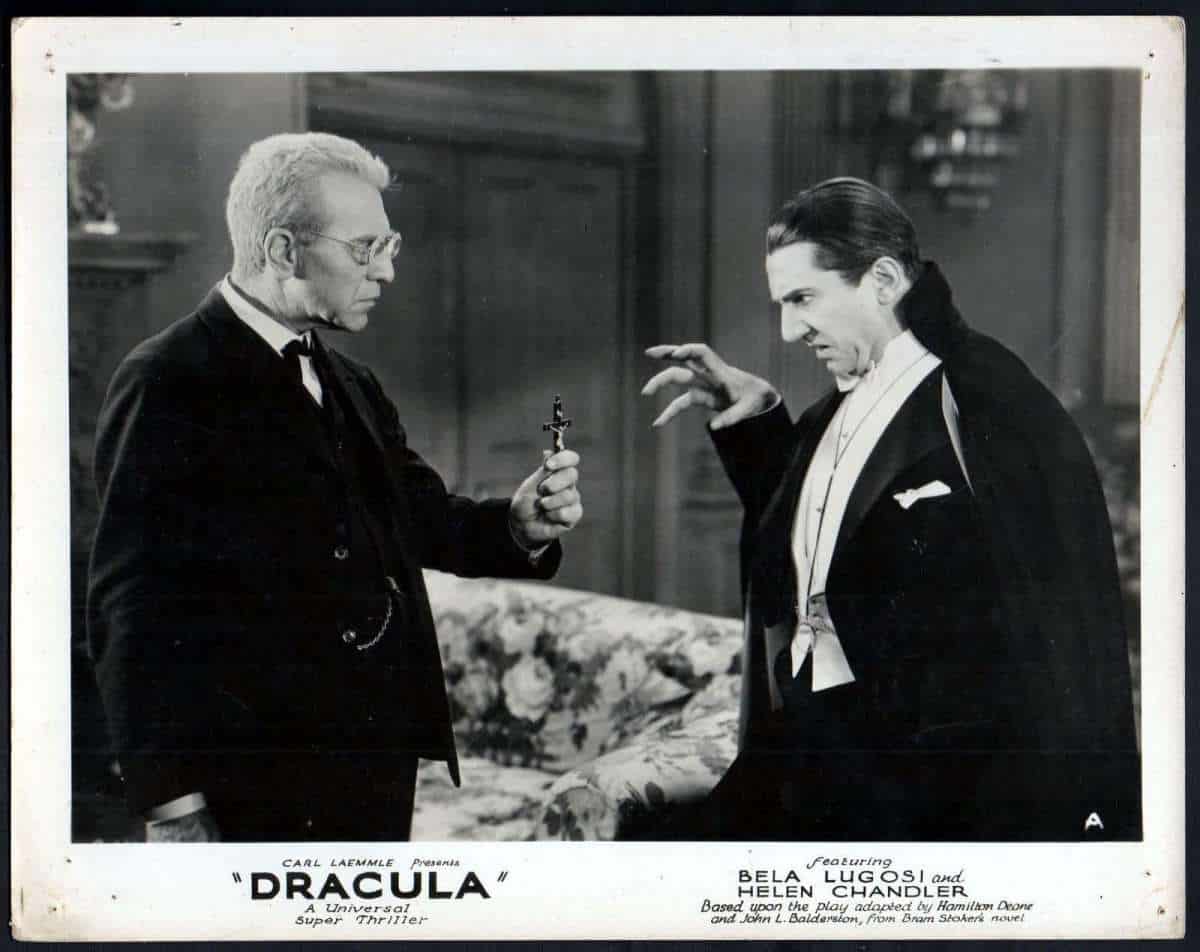It was 1931, the height of the Depression in the United States. People would do anything to escape the gloom and doom that was all around them. Their favorite activity was to trade in old Coke bottles and stacks of newspapers for the few pennies needed to get them into the neighborhood movie theater.
There, with their eyes wide open – or soon to be closed tight! – they could see that famous widow’s peak of slicked-back black hair on that famous brow as Bela Lugosi appeared at the top of the stairs in an old Transylvanian castle and uttered the words that would follow him to his own grave:
“I am….Dracula.”
The dreaded Count became even more famous in the 1950s, when old Universal monster movies began appearing on televisions throughout the country. TV’s Friday Night Fright Night pulled millions of baby boomer kids into that same Transylvanian darkness, albeit on a much smaller scale.
But The Count was still the same horrific presence, making us all shudder and sometimes even scream with mock terror and delight.
But who was he, really, with his strange accent and his almost mesmeric powers to make us all duck under our blankets when he appeared on the small screen?
Bela Lugosi was born Béla Ferenc Dezső Blaskó on October 20, 1882 in Lugos, Hungary, which was then part of the Austro-Hungarian Empire. His birthplace was only some fifty miles away from the western border of Transylvania and the Poenari Castle, the legendary home of Vlad the Impaler, the historical Dracula.
Read our article about incredible Hungarian movies with English subtitles!
Lugosi was a temperamental and rebellious child. He hated the strict discipline and formality of the State Gymnasium, and when he was 12 years old he dropped out of school and ran away from home.
It was while he worked odd jobs that he was captivated by the touring theatrical troupes, and it was then that he set his heart on becoming an actor. “They tried to give me little parts in their plays, but I was so uneducated, so stupid, people just laughed at me,” he recalled. “But I got the taste of the stage. I got, also, the rancid taste of humiliation.”
When he was around 16, he landed a place in the chorus of a traveling theater company. Displaying remarkable raw talent despite his lack of education or training, Lugosi quickly rose from the back of the chorus into leading roles. By the early 1900s, he was touring the Austro-Hungarian Empire, performing male lead roles in such Shakespearean classics as Romeo and Juliet, Hamlet and The Taming of the Shrew. In 1913, he joined the Hungarian National Theater in Budapest.
Over the next few years, Lugosi gradually transitioned from stage acting into performing in Hungary’s rapidly-growing silent film industry.
He also organized Hungary’s National Trade Union of Actors, the world’s first film actors’ union. He was a staunch supporter of the 1919 Hungarian Revolution that briefly brought Bela Kun’s Hungarian Soviet Republic into power; as a result, when the revolution collapsed Lugosi found himself a wanted enemy of the new government.
In 1919 he fled to Berlin, where he quickly found work in the German cinema. He appeared in several German films in 1920, most notably an adaptation of Robert Louis Stevenson’s Dr. Jekyll and Mr. Hyde.
Read our article and learn about the new generation of Hungarian filmmakers!
Despite this quick success in Germany, Lugosi decided to immigrate to the United States.
Upon arrival, he immediately made his way to New York City, where an already sizeable Hungarian theatrical community welcomed him with open arms. Despite not yet having a firm grasp of English, he made his English-language stage debut in 1922 when he memorized his lines phonetically. Since silent films still predominated, Lugosi’s language skills were not a barrier to his acting in American movies.
A bejegyzés megtekintése az Instagramon
In 1927, Lugosi accepted the title role in the American theatrical run of Dracula, a play based on Bram Stoker’s gothic novel of the same name. Lugosi’s Dracula was unlike any previous portrayals of the role. Handsome, mysterious and alluring, Lugosi’s Dracula was at once so sexy and so haunting that audiences gasped when he first opened his mouth to speak. After a half-year run on Broadway, Dracula toured the United States to much fanfare and critical acclaim. “It is a marvelous play,” Lugosi said. “We keep nurses and physicians in the theatre every night… for the people in the audience who faint.”
When “talking pictures” supplanted the silent movies, Universal decided to make a film version of Dracula starring Lugosi.
The 1931 film, entitled The Strangest Passion the World Has Ever Known, was a smash hit and forever immortalized Lugosi’s chilling portrayal of Dracula. Although countless actors have played Dracula since, to this date vampire enthusiasts idolize Lugosi as synonymous with the character.
A bejegyzés megtekintése az Instagramon
(NB: Americans tended to Anglicize his name, pronouncing it “Bell–a Loo-GO-see,” instead of using his native Hungarian pronunciation of “BAY-la LOO-go-shee.” Personally, I think the original pronunciation is much cooler.)
Throughout the 1930s, Lugosi was typecast as a Hollywood horror villain in dozens of B-list films. He was, however, eternally frustrated by his inability to break through into other types of films.
“I am definitely typed, doomed to be an exponent of evil,” he said. “But I want sympathetic roles. Then parents would tell their offspring, ‘Eat your spinach and you’ll grow up to be a nice man like Bela Lugosi.’ As it is, they threaten their children with me instead of the bogey-man.”
A bejegyzés megtekintése az Instagramon
After a few lean years in the late 1930s, when horror movies fell out of vogue in Hollywood, in the 1940s Lugosi once again began appearing in countless horror films as well as sequels and spoofs. Despite his prolific acting career and high profile, due to Universal’s ruthless compensation system and his own careless spending, Lugosi lived the majority of his adult life deeply mired in debt. In 1956, Lugosi began work on a sci-fi thriller called Plan 9 from Outer Space; however, he passed away in the middle of filming on August 16, 1956, aged 73. Lugosi was fittingly buried in his Dracula cape.
Bela Lugosi was a multi-talented and immensely gifted performer who had also mastered Shakespearean acting in Hungary before coming to define the American horror film genre.
Nevertheless, despite his dozens of films and stage performances, Lugosi lives on not so much as an actor but as the personification of his greatest character. Lugosi spoke for his own personal legacy as much as for his character when he pronounced the immortal line,
“I am….Dracula.”
NB: Did you know there’s a Dracula statue in Budapest? It’s actually a bust commemorating Béla Lugosi, one of the most famous impersonators of the infamous vampire-man.
A bejegyzés megtekintése az Instagramon




